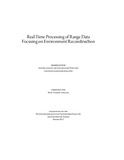Citation link:
https://nbn-resolving.org/urn:nbn:de:hbz:467-13972Files in This Item:
| File | Description | Size | Format | |
|---|---|---|---|---|
| Dissertation_Damien_Lefloch.pdf | 38.7 MB | Adobe PDF |  View/Open |
| Dokument Type: | Doctoral Thesis | metadata.dc.title: | Real-time processing of range data focusing on environment reconstruction | Authors: | Lefloch, Damien | Institute: | Fakultät IV - Naturwissenschaftlich-Technische Fakultät | Free keywords: | Real-Time, Range Data, Reconstruction ,Time-of-Flight, 3D | Dewey Decimal Classification: | 004 Informatik | GHBS-Clases: | TUH TVVC |
Issue Date: | 2017 | Publish Date: | 2019 | Abstract: | Durch die Verfügbarkeit von kostengünstigen Nahfeldsensoren, die 3D daten der aufgenommenen Szene in Echtzeit erstellen, entstehen neue Anwendungen im Bereich Computer Vision. Diese Anwendungen reichen von der Erstellung neuer Mensch-Maschine-Schnittstellen (bekannt als Natural User Interfaces) über die Erstellung von sehr detaillierten Rekonstruktionen komplexer Szenen (z.B. in der Spuren an Tatorten oder Kulturstätten) bis hin zu Autonomem Fahren und Erweiterter Realität. Diese Tiefensensoren basieren hauptsächlich auf zwei effizienten Technologien, dem: Structured- Light (SL) Prinzip (wie in der Xbox 360 Kinect Kamera) and Time-of-Flight (ToF) Prinzip (wie Kameras der Firma pmdtechnologies). Während ToF-Kameras die Zeit zwischen Lichtemission der Beleuchtungseinheit und Empfang der Rückstreuung auf dem ”smart detectors” messen, projizieren SL Kameras ein bekanntes Lichtmuster in die Szene und messen die Verzerrung zwischen ausgesendetem Muster und dem resultierenden Bild. Beide Technologien haben ihre Vor- und Nachteile. Diese Dissertation besteht aus vier Beiträgen. Wir schlagen einen effizienten Ansatz vor, um Bewegungsartefakte von ToF-Rohbildern zu kompensieren. Danach arbeiten wir an 3DRekonstruktionsanwendungen und verbessern die Robustheit des Kameratrackings durch die Segmentierung von bewegten Objekten. Der zweite Beitrag liegt in der robusten Handhabung von Rauschen in den Rohdaten über die ganze Verarbeitungskette der Rekonstruktion. Hier wird eine neue Art der Informationsfusion verwendet, welche die anisotropischen Eigenschaften von Rauschen in den Tiefendaten berücksichtigt und damit eine schnellere Konvergenz für hochqualitative Rekonstruktionen erzielt. Abschließend wird eine Methode entworfen welche die Information über die Oberflächenkrümmung verwendet um auch feine Strukturen von kleinen Objekten robust zu rekonstruieren. Zusätzlich wird der Gesamtfehler des Kameradrifts eingeschränkt. With the availability of affordable range imaging sensors, providing real-time three-dimensional information of the captured scene, new types of Computer Vision applications arise. Such applications range from designing new Human-Computer interfaces (known as Natural User Interfaces) to the generation of highly detailed reconstructions of complex scenes (for example to keep track of cultural heritage or crime scenes), to autonomous driving and augmented reality. These depth sensors are mostly based on two efficient technologies: the structured-light principle (such as the Xbox 360 version of the Kinect camera) and the time-of-flight (ToF) principle (as cameras implemented by pmdtechonologies). When ToF cameras measure the time until the light emitted by their illumination unit is backscattered to their smart detectors, the structured-light cameras project a known light pattern onto the scene and measure the amount of distortion between the emitted light pattern and its image. Both technologies have their own advantages and weak points. This dissertation is composed of 4 contributions. First, an efficient approach is proposed to compensate motion artifact of ToF raw images. Thereafter, a work on online three-dimensional reconstruction application has been investigated to improve the robustness of the camera tracker by segmenting moving objects. The second major contribution lies on a robust handling of noise on raw data, during the full reconstruction pipeline, proposing a new type of information fusion which considered the anisotropic nature of noise present on depth data, leading to faster convergence of high-quality reconstructions. Finally, a new method has been designed which uses surface curvature information to robustly reconstruct fine structures of small objects, as well as limiting the total error of camera drift. |
URN: | urn:nbn:de:hbz:467-13972 | URI: | https://dspace.ub.uni-siegen.de/handle/ubsi/1397 | License: | https://dspace.ub.uni-siegen.de/static/license.txt |
| Appears in Collections: | Hochschulschriften |
This item is protected by original copyright |
Page view(s)
668
checked on Jan 14, 2025
Download(s)
257
checked on Jan 14, 2025
Google ScholarTM
Check
Items in DSpace are protected by copyright, with all rights reserved, unless otherwise indicated.

